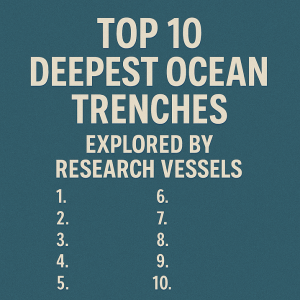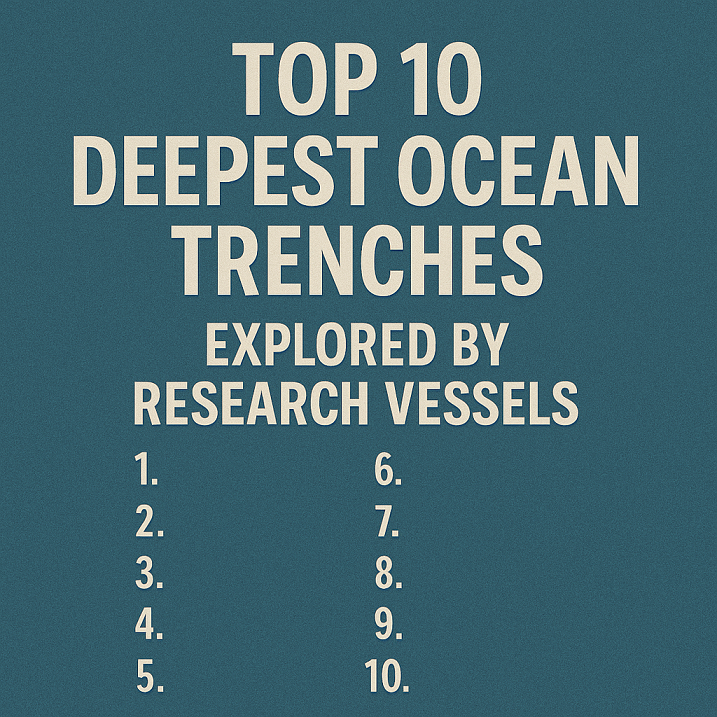 Explore the awe-inspiring world of deep-sea exploration. Discover the top 10 deepest ocean trenches ever explored by research vessels, and learn how cutting-edge technology is unlocking the mysteries of the ocean floor.
Explore the awe-inspiring world of deep-sea exploration. Discover the top 10 deepest ocean trenches ever explored by research vessels, and learn how cutting-edge technology is unlocking the mysteries of the ocean floor.
The ocean hides some of the most mysterious and extreme environments on Earth. Among these are the deep-sea trenches—massive geological depressions plunging thousands of meters beneath the surface. For centuries, these abyssal realms were shrouded in darkness, untouched by human eyes. Today, thanks to powerful research vessels and advanced submersibles, we are beginning to illuminate these hidden worlds. This article explores the top 10 deepest ocean trenches that have been explored by humans using state-of-the-art maritime technology.
Why Deep Ocean Trenches Matter in Maritime Science
Deep-sea trenches are more than just underwater curiosities. These regions are crucial for:
- Understanding plate tectonics and subduction zones (as described in the International Journal of Earth Sciences)
- Discovering extremophiles—microorganisms that thrive in conditions once thought impossible
- Studying marine biodiversity and potential pharmaceutical compounds (World Ocean Review, 2022)
- Monitoring seismic and tsunami risks, particularly in areas like the Japan Trench and Tonga Trench
Moreover, as noted by the UNESCO Intergovernmental Oceanographic Commission (IOC), only 20% of the global seabed has been mapped with modern sonar—highlighting how much remains to be explored.
The Technology Behind Deep-Sea Exploration
Exploring deep ocean trenches requires specialized tools. Research vessels like DSV Limiting Factor, RV Falkor, and RV Kairei employ:
- Multi-beam echo sounders for high-resolution seabed mapping
- Remotely Operated Vehicles (ROVs) such as the ROV Victor 6000 by IFREMER
- Autonomous Underwater Vehicles (AUVs) that can dive independently for over 24 hours
- Titanium-structured manned submersibles, e.g., DSV Deepsea Challenger piloted by James Cameron to the Mariana Trench
These technologies must withstand pressures exceeding 1,000 times atmospheric levels, making engineering reliability essential. Classification societies like DNV and Lloyd’s Register have provided frameworks for pressure vessel certification.
Mariana Trench – Challenger Deep (10,984 meters)
- Location: Western Pacific Ocean
- Research Vessels: DSV Limiting Factor, Deepsea Challenger
- Highlights: The Mariana Trench is Earth’s deepest known point. Challenger Deep, its lowest spot, was first measured by the HMS Challenger expedition in 1875 and later explored by Don Walsh and Jacques Piccard in 1960 aboard the Trieste. In 2012, filmmaker James Cameron made a solo dive to the trench’s depths.
Studies here have revealed polychaete worms, amphipods, and even plastic pollution, underscoring how human impact reaches even the deepest places.
Tonga Trench (10,882 meters)
- Location: South Pacific Ocean
- Research Vessels: RV Tangaroa, RV Falkor
- Highlights: The Tonga Trench is the second-deepest after the Mariana, known for violent seismic activity. In 2019, Victor Vescovo descended to the Horizon Deep aboard the DSV Limiting Factor, collecting rare sediment and microbial samples for genomic study.
Philippine Trench (10,540 meters)
- Location: Philippine Sea
- Research Vessels: DSSV Pressure Drop, BRP Hydrographer Ventura
- Highlights: This trench lies along a major tectonic subduction zone. Oceanographers have found evidence of carbon flux processes and high-pressure adaptation in fish species like Pseudoliparis swirei.
Kuril–Kamchatka Trench (10,500 meters)
- Location: Northwest Pacific off Russia and Japan
- Research Vessels: Russian R/V Akademik Mstislav Keldysh
- Highlights: This region is highly active tectonically, often experiencing megathrust earthquakes. Geological research contributes to tsunami early-warning systems, particularly important for northern Japan.
Kermadec Trench (10,047 meters)
- Location: South Pacific Ocean, north of New Zealand
- Research Vessels: NOAA’s Okeanos Explorer, NIWA vessels
- Highlights: The trench has been explored for its chemolithoautotrophic microbial life—organisms that derive energy from inorganic chemical reactions, a potential key to understanding extraterrestrial life.
Japan Trench (9,000+ meters)
- Location: Off the coast of Honshu, Japan
- Research Vessels: JAMSTEC’s RV Kairei
- Highlights: This trench was the source of the catastrophic 2011 Tōhoku earthquake and tsunami. Continuous monitoring by JAMSTEC has led to advances in deep-sea fiber optic seismometers.
Puerto Rico Trench (8,376 meters)
- Location: North Atlantic Ocean
- Research Vessels: NOAA Ship Ronald H. Brown
- Highlights: As the deepest part of the Atlantic, the Puerto Rico Trench holds both geophysical and geopolitical interest. The US Geological Survey (USGS) uses it to model Caribbean subduction dynamics.
South Sandwich Trench (8,264 meters)
- Location: Southern Atlantic, near South Georgia Islands
- Research Vessels: British Antarctic Survey vessels
- Highlights: A recent dive by DSV Limiting Factor in 2021 marked the first human descent to the trench’s bottom. Scientists found amphipods adapted to near-freezing, high-pressure conditions.
Sunda Trench (7,725 meters)
- Location: Indian Ocean, off Indonesia
- Research Vessels: Indonesian BRIN research vessels, RV Sonne
- Highlights: Also known as the Java Trench, it is notorious for the 2004 Indian Ocean earthquake and tsunami. Indonesian authorities and the International Tsunami Information Center (ITIC) closely monitor the trench with deep-sea buoy systems.
Peru–Chile Trench (8,065 meters)
- Location: Southeastern Pacific
- Research Vessels: RV Sonne (Germany), Peruvian IMARPE vessels
- Highlights: Stretching over 5,900 km, this trench influences regional upwelling systems vital for Peru’s massive anchoveta fishery—one of the largest in the world.
Real-World Applications of Deep-Sea Trench Research
The knowledge gained from these explorations has a broad impact:
- Tsunami prediction: Deployments of ocean-bottom seismographs (OBS) and pressure sensors
- Marine biodiversity protection: Discovery of new species for conservation and pharmacology
- Climate science: Sediment cores help reconstruct Earth’s climate history
- Underwater engineering: Deep-sea drilling tests for oil/gas and rare-earth minerals
According to a 2023 study by Springer’s Marine Structures Journal, trench pressure testing has also advanced subsea cable and hull design for future ocean-going vessels.
Challenges and Innovations in Exploring the Abyss
While our capabilities are growing, challenges remain:
- Pressure and material limits: Even titanium alloys have constraints in ultra-deep dives
- Cost: A single trench expedition can exceed USD 50 million (Scripps Institution of Oceanography)
- Risk: Communication blackouts, implosion, and navigational issues in pitch darkness
That said, new materials like ceramic matrix composites and artificial intelligence-based piloting are changing the game. Organizations like the Seabed 2030 Project (a collaboration between GEBCO and the Nippon Foundation) aim to map the entire seafloor by 2030.
Frequently Asked Questions (FAQ)
How deep is the Mariana Trench really?
The Challenger Deep in the Mariana Trench is about 10,984 meters (36,037 feet) deep, though measurements can vary slightly by method and year.
Have all ocean trenches been explored?
No. While the top 10 have been visited or studied with probes, many deep regions remain unmapped or unexplored due to cost and technical challenges.
What kind of life exists in deep trenches?
Extremophiles, including amphipods, polychaetes, and high-pressure bacteria. Some species use chemosynthesis rather than sunlight.
Can humans survive a trench dive?
Only in specially designed submersibles like the DSV Limiting Factor or Trieste. Pressure at these depths would crush unprotected humans instantly.
Why is trench research important for climate science?
Sediment layers reveal past climate conditions, helping scientists understand long-term carbon cycles and ocean temperature shifts.
Conclusion
Exploring the world’s deepest ocean trenches isn’t just an academic exercise—it’s a journey into Earth’s last true frontier. These abyssal zones reveal vital insights into geology, biology, and even the resilience of life. From tracking tectonic movements to discovering new marine species, each descent brings us closer to understanding the ocean’s deepest secrets. As research vessels grow smarter, stronger, and more autonomous, we inch ever closer to unlocking the full map of our blue planet.
References
- UNESCO IOC – Ocean Mapping
- NOAA Office of Ocean Exploration
- JAMSTEC – Japan Agency for Marine-Earth Science and Technology
- GEBCO – Seabed 2030 Project
- World Ocean Review, 2022
- Springer Journal: Marine Structures
- Scripps Institution of Oceanography
- The Royal Institution of Naval Architects (RINA)
- IFREMER Deep-Sea Research
- NOAA Deep Sea Coral Research
- CLIA Global Cruise Industry Guide
- BIMCO – Marine Technology Developments

